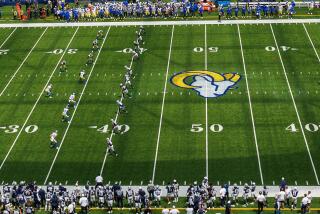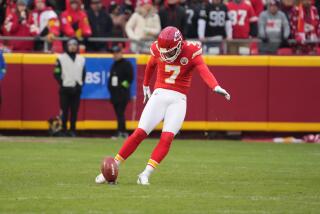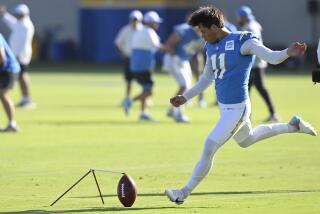A NEW ICE AGE
- Share via
It might have been the record 157 shutouts teams recorded last season that yanked NHL executives’ heads out of the sand.
Or maybe it was the sight of goaltenders wearing shoulder pads more suited for linebackers and jerseys voluminous enough to swallow stray animals along with stray pucks.
Then again, it might have been seeing one tedious neutral-zone trap too many that led general managers to approve a series of offense-friendly rule changes that will take effect Friday, when the NHL opens its 82nd season.
Even the NHL’s conservative caretakers could no longer ignore the scoring decline of recent years. Goal production fell from 5.8 goals a game in 1996-97 to 5.28 last season, and Pittsburgh’s Jaromir Jagr, with 102 points, was the only player to reach 100. Not since 1969-70 had so few players scored 100 points.
TV ratings dropped too--coincidence or correlation?
Commissioner Gary Bettman said boosting goal scoring wasn’t an urgent concern, but he acknowledged a need for “tweaking” rules to “make things a little fairer for everyone.”
He added, “I don’t think I’d use the word ‘imperative.’ I think in terms of watching and listening, we’re doing the right type of fine-tuning. Our sense was we didn’t need radical changes, but defense had gotten a little bit of an edge over offense, and we wanted to make sure the trend headed in the other direction.”
A committee of general managers--Lou Lamoriello of New Jersey, Craig Patrick of Pittsburgh, Bob Clarke of Philadelphia, Glen Sather of Edmonton, Harry Sinden of Boston and Jack Ferreira of the Mighty Ducks--discussed a variety of changes before recommending several that were adopted in a full vote.
The key differences are limits on the size of goaltenders’ equipment, moving goal lines two feet out from the end boards to 13 feet, reducing the size of the goal crease, and implementing a two-referee system. The changes produced the desired results in exhibition games: According to the NHL, scoring in the first 104 exhibitions was up .3 goals over the same number of games a year ago.
“The changes made were to adjust a little bit to where the game has come and to the size and skill of the players and the adjustments that have been made in the league, especially in reference to defense,” Lamoriello said. “Coaching has never been better, and with the way the game has changed with reference to defense, the reason the goaltending is so good, besides the improvement in training methods, is the defensive posture of teams.”
The most obvious change was moving the nets farther out. That makes it more difficult for goaltenders to play dump-ins and is likely to result in more energetic forechecking.
“If the puck is shot around, there’s no sense in going out there,” said Phil Myre, a former NHL goalie who scouts for the Ottawa Senators. “I anticipate a lot of shotgun plays, a lot of walkouts and pass-out plays from behind the net. I’ve already seen a lot [in exhibition games], and when the skill players get more playing time, you’ll see more.”
Said Mighty Duck goalie Guy Hebert: “Making some room behind the net is going to force goalies to stay in the net more. Guys who like to roam, like Patrick Roy and Ron Hextall, won’t be able to as much.
“It’s going to help goal scoring. Just think of Wayne Gretzky behind the net with Brian Leetch coming down the slot. That’s going to be a dream for those two. Hopefully, we have Paul [Kariya] behind the net feeding Teemu [Selanne].”
Colin Campbell, the NHL’s new senior vice president for hockey operations, predicted a jump in power-play production, which has fallen from an average efficiency of 19.6% in 1992-93 to 15.1% last season. Last season, only the Dallas Stars hit 20%, which used to be the minimum standard.
“I think we’re going to see a real difference in down-low power plays with the goal line out,” Campbell said, “and teams just going and blasting it down the middle.”
Changing the shape of the goal crease from semicircular to rectangular and shrinking it by two feet on each side means there’s less forbidden territory for attacking players to encroach on, which means fewer goals will be waved off because someone had a toenail in the crease.
“You’ll see players going to the net, but not going at the goaltender,” Campbell said. “You can drive to the net and go by it without getting caught in the crease.”
Goalies struggled to adapt during exhibition games. “It was really different. It’s narrow in front and it was hard for [judging] the angles,” King goalie Stephane Fiset said. “We’re used to just looking at the ice and knowing where we’re at and where the net is.”
Again focusing on goalies, the NHL set limits for the size of their jerseys, catching gloves, chest and arm pads and shoulder cap protectors.
Banned are the oversized pants that blocked the five-hole (space between the legs) of even the least acrobatic goalie. Gone are bat-wing sleeves with folds of material that swallowed shots when the goalie was out of position. No more pads extending past the shoulders like airport runways, as the pads of Vancouver’s Garth Snow did last season.
“Snow was the one drop that spilled the glass,” Myre said. “Anything that protrudes, they shouldn’t allow, like the shoulder pads and some of the pants. I don’t disagree, as long as everybody is the same. I think it’s good for everybody to be on the same level. As long as the protection is there and the movement is there, there’s no problem. Then it’s fair.”
Kariya applauded the standards. “I think that might help a lot in the goal-scoring department because you take shots sometimes and you beat the goalie, but you don’t beat his equipment,” he said. “Especially shots between the arm and the body, a lot of times the jersey catches that.”
However, bigger goalies are concerned about the jersey’s fit. The maximum size is 58, two sizes smaller than 6-foot-3, 225-pound Olaf Kolzig of Washington wore last season and one size down for 6-1, 205-pound Martin Brodeur of New Jersey. Dave Dryden, a former NHL goalie who is a consultant for the NHL’s hockey operations department, has indicated players might get exemptions on a case-by-case basis, such as those who can’t squeeze into the jersey or need special pads to protect shoulder or elbow injuries.
Fiset, 6-1 and 195 pounds, is also wearing a smaller jersey, but the rest of his equipment is larger. “It’s not a big difference,” he said. “We’re the same goalies and we’re still good. The only thing this year is the player is going to see a little more of the net.”
The two-referee system is the biggest and most controversial change.
It will be implemented in 270 games between Friday and Feb. 28, and each team will play 10 home games and 10 road games under that system. One referee will cover deep into each end zone. The “back” referee will stay outside the zone to watch peripheral areas and the “deep” referee will watch the action. Either may make calls over the entire ice surface. Use of the two-referee system in the playoffs has not been approved but is possible, Bettman said.
In theory, the extra set of eyes will see more penalties, especially fouls behind the play. Eventually players will learn to commit fewer penalties, creating a better flow of play. In the first 104 exhibition games, there were more penalties and penalty minutes per game under the two-referee system than with one referee (22.5 penalties and 63.7 penalty minutes, compared to 19 penalties and 52.4 minutes). Yet, games officiated by two referees were five minutes faster than with one, at an average of 2 hours 34 minutes. “It’s working far better than we anticipated at the start,” said Bryan Lewis, the NHL’s director of officiating. “We’re extremely comfortable with it.”
So is King Coach Larry Robinson. “I like it a lot better than the one-referee system,” he said. “They see so much more. It takes away a lot of the cheap stuff.”
However, acceptance isn’t unanimous. “It’s a waste of space. They don’t do anything one guy can’t do,” Dallas winger Brett Hull said. “One guy has been doing it all these years, and I don’t think you need two.”
The Flyers also objected. “The stinking referees want to see who can make the most calls. No, I don’t like this at all,” Coach Roger Neilson said. Said Clarke: “It’s horrible, just horrible. Two referees isn’t going to work.”
Lamoriello saw the two-referee system when he coached at Providence College and wasn’t a big fan. He’s reserving judgment on its use in the NHL and hopes fans and players will be open-minded about all the changes.
“Basketball took out the zone defense and went to the man-to-man defense. By moving the crease out and decreasing the crease size, we felt it would add to our game. Eventually players will see the benefits,” he said. “We’re trying to keep more movement, more forechecking, and with more movement you’re going to get more skating. . . . We’ve looked at other leagues: football, with video replay, baseball with certain areas, basketball with additional officials. We have a great game and anything we do should be done to enhance it, not change for the sake of change. Time will tell if we’ve succeeded.”
(BEGIN TEXT OF INFOBOX / INFOGRAPHIC)
RINK CHANGES
Goal Crease
To cut down on in-the-crease violations, the size is decreased with the crease extending onlyone foot beyond each goal post.
Neutral zone
The goal lines, blue lines and defensive zone face-off circles are moved two feet closer to center, shrinking the neutral zone from 58 feet to 54 feet.
GOALIE CHANGES
Wrists
No tying down of the sweater that creates tension across the jerseysuch that a “webbing effect” is created in the armpit area.
Jersey length
Illegal if it covers any area between the goalie’s legs.
Pad width
Maximum width is 11 inches.
Leg pads
No internal or external padding allowed on the pant leg or waist beyond that to provide protection (no outside or inside ridges).
Smaller gussets
Armpit sections are to be 4-inch wide diamonds
GOALIE SIZE BEFORE 1998-99 SEASON
Going for the Goals
Key changes in NHL this season:
* Goal lines have been moved out two feet from end boards, leaving 13 feet behind each net. The neutral zone has been reduced from 58 feet to 54.
* The crease has been reduced in width by two feet on each side.
* The video goal judge will be permitted to call the referee to advise that an offensive player was in the crease before the puck at the time a goal was scored. The referee will still determine whether the player was pushed into the crease or held in the crease by the defending team. The previous rule stipulated only the referee could request a ruling if he thought an attacking player was in the crease.
* Two referees will be used in 270 games between Oct. 16 and Feb. 28.
* Rules were established to standardize the dimensions of goaltenders’ equipment, including the catching glove, chest and arm pads, shoulder cap protectors, pants and jerseys.
More to Read
Go beyond the scoreboard
Get the latest on L.A.'s teams in the daily Sports Report newsletter.
You may occasionally receive promotional content from the Los Angeles Times.







